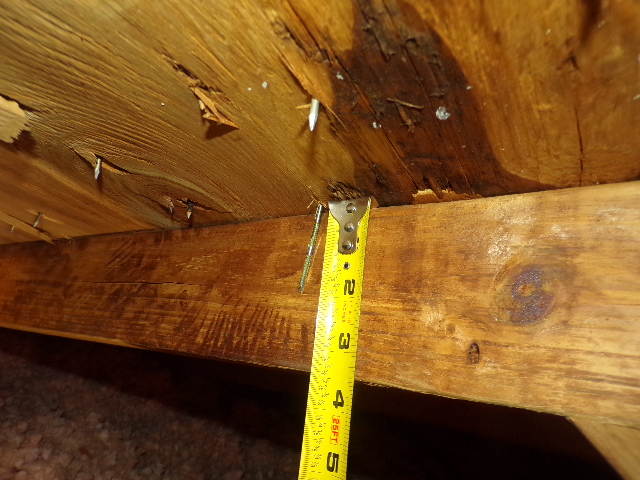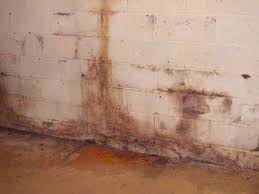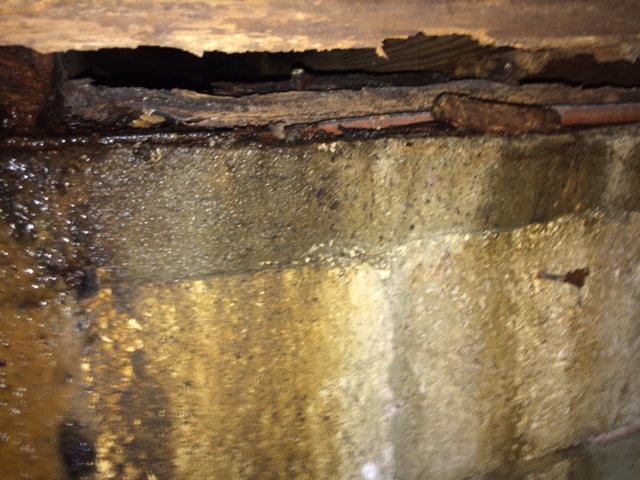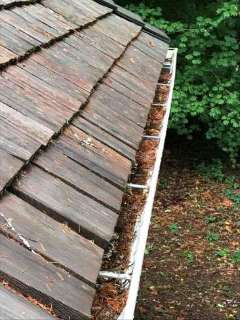In the picture I submitted there is clearly some moisture intrusion coming from the roof. As I measured a nail when performing a wind mitigation I noticed there was a slight leak resulting in some slight water damage to the decking.

In the picture I submitted there is clearly some moisture intrusion coming from the roof. As I measured a nail when performing a wind mitigation I noticed there was a slight leak resulting in some slight water damage to the decking.

The article I chose was ways to protect your property from water damage. I learned the numerous ways water can enter the home through HVAC systems, roof leaks, windows or doors, and also foundation and exterior walls. Plumbing systems can also leak and damage or corrode the interior.
All the gutters should be evaluated for correct pitch in installation by a qualified installer.
Downspouts were not connected at time of inspection.
Downspouts missing; recommend installation.
The soffit vent noted as loose. Recommend review for repair or replacement as necessary.
upon arrival to this property inspection i found this garage was in need of repair due to numerous issues. first was slope issue to exterior wall were slope was graded into garage,second was termite infestation and lastly was window cracks allowing water to enter.homeowner notified and communicated observations.
today i have learned how efflorescence can occur from water entering soil and quickly being transferred into brick and potentially cause damage to structual components and structure,capillary action is and should be a concern for all homeowners that are not familiar with this term and somehow educated upon a purchase.
Boots that are in question. These are pictures of a couple of boots on an inspection that I recently did. I didn’t call the boots defective because the meat was still there and doing its job. I did recommend they be nailed and sealed.
Water intrusion will destroy your house if you let it go too far. This course has improved my where-with-all about finding problematic places water wants to go. Ben has done an outstanding job with his pictures and narratives. Thanks Ben.
Missing shingles, granules filling the gutters, water stains on the ceiling after rainstormsthey all point to roofing problems. … It can travel along roof panels or lumber in the attic before dripping onto your insulation and leaving the telltale, causing severe damages to a home.

Water damage can take on different colors, textures, and even smells, depending on the type of location of the damage. For instance, ceiling water damage is usually easier to spot than water damage in a basement because you will see stains and discoloration on a ceiling, but may not know that a musty odor can be a sign that there is a problem on the lower level of your home. Learn these telltale signs so that you can identify an existing problem and be prepared to spot it in the future.
This image is of kick out flashing. This component will help direct water that comes down the roof into the gutter. If this flashing were not there the water could flow over the gutter and down the sidewall causing moisture intrusion.

I read the article about emailing nachi.org before you call. This allows your question to get routed to the right person and prevents you from being placed on hold. It also allows for a written record of the conversation which will allow you to refer back when needed.
This a barbaric Air Conditioner man, that directed the 3/4 " discharge drain pipe, strait down, from the air handler, to the crawl space, the green gel, it is about 1/8" tic, the first was connect an elbow to the discharge, after was the installation of an 8" x 3/4" diameter and have the A/C unit discharge outside the house,. The second step was attack the gel and heavy mildew, using chlorine and heavy brushing, Rebuild all broken beams and jack the house, to the original level, I have pictures of the job finish, at very end, the wood will be wet spay, with Holmes mold and mildew treatment, it goes light brown and looks new.

oisture intrusion can be the cause of building defects, as well as health ailments for the building’s occupants. Inspectors should have at least a basic understanding of how moisture may enter a building, and where problem areas commonly occur.
Some common moisture-related problems include:
structural wood decay;
high indoor humidity and resulting condensation;
expansive soil, which may crack the foundation through changes in volume, or softened soil, which may lose its ability to support an overlying structure;
undermined foundations;
metal corrosion;
ice dams; and
mold growth. Mold can only grow in the presence of high levels of moisture. People who suffer from the following conditions can be seriously (even fatally) harmed if exposed to elevated levels of airborne mold spores:
asthma;
allergies;
lung disease; and/or
compromised immune systems.
Note: People who do not suffer from these ailments may still be harmed by elevated levels of airborne mold spores.
How does moisture get into the house?
Moisture or water vapor moves into a house in the following ways:
air infiltration. Air movement accounts for more than 98% of all water vapor movement in building cavities. Air naturally moves from high-pressure areas to lower ones by the easiest path possible, such as a hole or crack in the building envelope. Moisture transfer by air currents is very fast (in the range of several hundred cubic feet of air per minute). Replacement air will infiltrate through the building envelope unless unintended air paths are carefully and permanently sealed;
by diffusion through building material. Most building materials slow moisture diffusion, to a large degree, although they never stop it completely;
leaks from roof;
plumbing leaks;
flooding, which can be caused by seepage from runoff or rising groundwater; it may be seasonal or catastrophic; and. Down here in south Florida, houses do not have a 6 mil, plastic barrier, the soil is humid and wet, the weather inside is maintained at a minimum of 75 F/H, with a acclimatized, A/C, system, the worst moist intrusion, occur, when the cold dry air, encounters the heavy, semi tropical air, when people lives windows open, with the A/C on, black heavy mildew, drippy stains, plus fungus, it eventually destroys the dry wall and will rotten adjacent wood.
Significant amounts of debris have accumulated in one or more gutters or downspouts. Gutters can overflow and cause water to come in contact with the building exterior, or water can accumulate around the foundation. This is a conducive condition for wood-destroying organisms. Recommend cleaning gutters and downspouts now and as necessary in the future.

Deck Inspection;
On performing a deck inspection, it is important to make sure if the ledger board is correctly bolted to the home and properly flashed. Ensure the balusters have the appropriate spacing (4" or less) and that tread depth and width are correct.
Missing insulation. By having incorrect insulation around the Rim joist, It’s creates an air leak that can create a condensation issue, in colder climates such as mine. Also it makes it harder to heat the area. Finally, the insulation should be covered with flame retardant materials, such a s gyproc.
Cold Air infiltration picture. The windows not being air tight let’s cold air into the house. Not having a heating element (baseboard or air duct) under let’s the cold damp air stay in the area, protected by the curtains. ventilation important to prevent such problems. (aside from good quality windows in the first place)
As noticed in the attached picture from the basement.We notice the presence of Efflorescence
on the concrete walls. This dissolved salts deposits are created either by moisture resulted from groundwater or rainwater.This is the indication of moisture intrusion.that is often caused by poor ventilation and insulation.

In this picture you see the dryer vents for the laundry room in my condo. These vents appear to be in good condition and free from much visible lint buildup, but they are missing there damper or rain shield to keep out rain or insects or pests.
Clothes dryers evaporate the water from wet clothing by blowing hot air past them while they tumble inside a spinning drum. Heat is provided by an electrical heating element or gas burner. Some heavy garment loads can contain more than a gallon of water which, during the drying process, will become airborne water vapor and leave the dryer and home through an exhaust duct or dryer vent.These ducts must be kept free of excess lint to help prevent a fire. Many of these types of fires happen every year in the US.